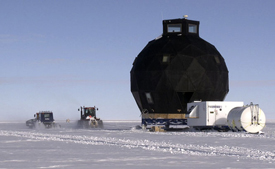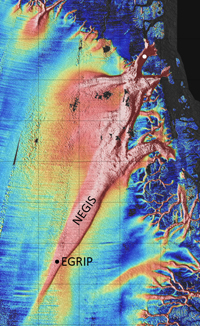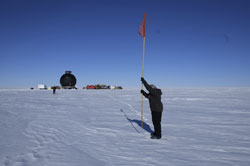Research station moved nearly 500 km across the Greenland ice sheet
The entire research station NEEM has been moved 465 km across the Greenland ice sheet on skis to the new camp EGRIP, where there will be a future international drilling camp and a gateway to research programmes in East Greenland.

The 14-meter high building, the ‘Dome’, weighing 47 tons, is on skis and is being pulled across the snow by two tracked vehicles.
“We arrived at the EGRIP position at 16:00 today. We stopped just outside the camp area to survey the camp before placing the Dome and raising the garage tents. We happy and relieved that this crazy plan to pull the huge Dome across the ice succeeded. We feel like modern pioneers,” explains Jørgen Peder Steffensen, ice core researcher and field leader, Centre for Ice and Climate, Niels Bohr Institute, University of Copenhagen.
Fast flowing ice
The project involves drilling a 2½ kilometer deep ice core through the fast flowing part of the ice sheet. The drilling will be carried out in the large ice stream in Northeast Greenland. An ice stream is an area in the ice where the ice is flowing around 60 meters per year.
Little is known about how the ice in the ice sheet moves, so the aim of the project is to gain more knowledge about how ice streams are contributing to the rapidly increasing loss of the Greenland ice sheet. Knowledge about how and how fast the ice is moving could improve forecasts of sea level rise in the coming years.
Buildings on skis
The EGRIP camp was planned as a mobile infrastructure where all of the buildings are on skis. Compared with bases on the ice in Antarctica, EGRIP is a very innovative way of having a base on the ice, which meets all of the requirements for the environment. Snow is deposited on the ice each year, so the buildings on the ice slowly ‘drown’. Bases on the ice thus have a relatively short lifespan.

The new drilling will take place in the large ice stream in Northeast Greenland. The ice stream begins near the peak of the ice sheet and stretches out to the coast, where it splits into three large ice streams. The surface velocity of the ice is shown with colour. The dark colour flows more than 150 meters a year.
The EGRIP buildings will not disappear in the snow because they are mobile and can be pulled up on the new snow surface periodically. The main building is a 14-meter high ‘Dome’, weighing 47 tons. The Dome and 11 large sleds with a combined weight of 150 tons was pulled by five tracked vehicles from the old camp NEEM to EGRIP from 18-26 May.
“Never before has an entire camp been pulled so far across the ice and we are very proud that it was possible. It was like pulling our own snail shell over the ice. Every evening the 11 participants could eat and sleep in the large, well-equipped Dome,” says Jørgen Peder Steffensen.
Now they are looking forward to setting up the camp and starting the deep drilling next year.
The project would not be possible without support from the A.P. Møller Foundation, University of Copenhagen, the Alfred Wegener Institute (Germany), Bjerkness Centre (Norway) and the National Science Foundation (USA), who provided staff and a tracked vehicle.

